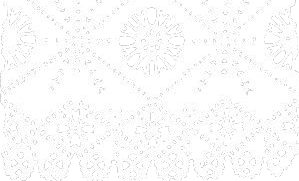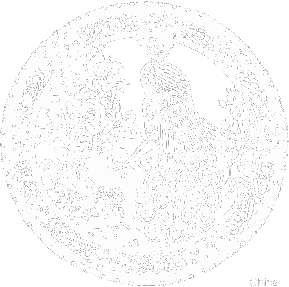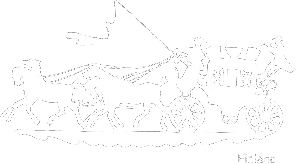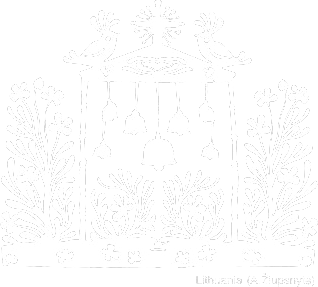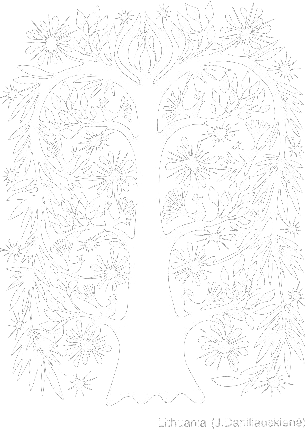|
Albina Žiupsnytė LITHUANIAN PAPERCUTS
There is currently a renewed interest in the art of paper cutting. In Lithuania, paper cutting has been practiced since the 16th c. The first uses of this art might have been stencils for document seals. A wax seal was applied over a papercut design. In the 19th c. paper cutting became especially popular in the everyday life of country people. /Gizevijus/ wrote that at weddings he observed horses, cows, birds, nets, ears cut from paper and hung in the bride’s corner or made into decorations with herbs. By the end of the 19th c. paper cutting was no longer confined to special occasions such as festivals, but was being used in decorations for the home: to cover a window, to decorate a shelf, a lamp, frames of a mirror or a picture or edges of a coffin. Paper cutting to decorate everyday objects was widespread, and hence we have more information about it. Old papercuts closely reflect national traditions and evoke no doubts about their national origins. Modern paper cutting shows two different tendencies: the first continues folk traditions in its style, ornamentations and rhythm; the second is free, non-symmetrical,cut without folding the paper, similar to the silhouette picture, static in quality,imitating scenery and portrait. These two tendencies are seldom discussed separately, and any work of art cut from paper falls under the rubric of paper cutting. Some identify papercuts closely with graphic arts. So the question arises whether we can still consider paper cutting as a kind of folk art, expressing the particularities of national character. Perhaps modern paper cutting is already losing its originality and becoming international? To answer this, we shall examine how Lithuanian papercut patterns differ from those of China, Germany, Russia and Poland. A comparison of Lithuanian and Oriental paper cutting illuminates the features specific to the Lithuanian art. Our understanding of the essence of paper cutting differs totally from that of the Chinese, Vietnamese,Japanese and Koreans. Lithuanian papercut designs take as their main motif the image of the mythic TREE, the central axis of Indo-European culture. Our folk art frequently uses images of the Cosmic Tree, the Tree of Life: chests painted with trees and plants, needlework decorated with blossoms, branches, trees next to the images of animals; wooden statues made in a shape of flowers; spindles... The same motif appears in papercuts. It has been said that every Lithuanian pattern designer creates his own tree and bird. The image of blooming trees, perched upon by birds, surrounded by stars,sun and moon, recurs most often. But papercuts have an even deeper relationship to the mythic image of the tree, because the very technique of designing the cutting pattern by folding paper at the center particularly fits the design of a tree: the trunk as a symmetrical axis with the branches around it. The principle of symmetry aids the designer in creating the image of a tree. The use of this motif has a rationale. The Indo-European mind-frame views the world as the tree that unifies the lower, middle, and upper levels of the skies.
Shelf-spread (Lithuania) Now let us look at Chinese paper cutting. This tradition of pattern design is very old as papermaking was discovered in China 2000 years ago. Paper cutting is very popular in China. Every Chinese province has its own paper patterns. On the occasion of any festival, the Chinese give each other hand-made cards cut with various images of birds and flowers that have symbolic meaning. The Chinese cut patterns not with scissors, but with special sharp instruments. They stack 20-30 sheets of thin paper on a small board and cut them all together exactly along the contours of a stencil that is placed on top. The possibility of cutting so many designs at once must be one of the reasons for their popularity. China exports quite a lot of pattern designs. The technique of cutting with a knife and not with scissors allows for the creation of a non-symmetrical picture. Oriental art does not make use of very many kinds of symmetrical designs. Orientals have their own motifs (dragons, chrysanthemums, bouquets in vases, actors,dancers, masks),and these motifs share common features: the plasticity of lines in paper patterns and composition specially designed for oval surfaces. In most of the designs the rounded frame becomes an inseparable part cut together with the design. An oval surface or a circle symbolizes the characteristic Oriental world outlook. Orientals picture the world as born from the Cosmic Egg and the process of creation as having started at one point,the center, which reveals the form while being encircled by it...Of course, it would be wrong to claim that Lithuanians do not also use the symbol of an egg or that the Chinese don’t have the symbol of a tree. Human beings of all cultures and nationalities use the same symbols in their decorations and art. True, we decorate /margučiai/ (Easter eggs) with the ornamentation of plants, trees, and Chinese people have celebrations at which they decorate trees. However, one can discern a greater emphasis on a certain symbol in each nation. Oriental art is characterized by the streamlined “egg” contours, e.g., Chinese vases painted with pictures of plants, animals,people, mythical creatures. While in Europe the tree is the most popular symbol, often designed not only as an imitation of a natural tree, but also as a cross (in Lithuania) engraved with plant motifs (writers of chronicles thought it resembled a tree more than a cross).
At first impression the Oriental art of paper cutting appears to be superior to ours. The principle of symmetry limits the Lithuanian pattern designer. It is rather tempting to cut a non-symmetrical pattern, and to create an image to impress the viewer with the designer’s skill. But the originality of paper patterns is revealed not by the ability to cut with precision. A professional designer knows that it is possible to cut out almost anything and to make the cut resemble graphics. This can be clearly seen in the works of Swedish, Finnish, German designers, such as the portrait silhouettes of Goethe’s times or modern books illustrated with papercuts. Their specific feature is that they are intended to imitate nature and contain some details of fantasy. Thus, the paper cut that requires so much patience from a designer becomes equal to rather simple graphical works, which can be done much quicker in India ink or some other similar technique. We think that it makes no sense to cut paper when the same result can be achieved by painting. On the other hand, painting something completely symmetric raises some difficulties. A designer who wants to paint a few identical things must plan and work carefully and cleverly: draw an image on a separate sheet of paper, copy it by putting it in a light box, or torment him/herself with rulers and compasses... Luckily, in graphics, as in most arts, symmetric duplication is used rather seldom. Rather, the artist generally tries to enrich the composition with as many elements as possible, in order to take advantage of the genre. Indeed, graphics presents many possibilities and freedom of choice regarding the technique, and it would be strange to ignore that aspect of the medium. Thus, symmetry differentiates paper cutting from graphics and defines it as a separate genre. Of course, scissors and paper folds limit the design. The principle of symmetry becomes its basis and strongest factor. The repetition of elements created by folding paper several times allows the possibility of disclosing the BEAUTY of SYMMETRY, its internal power expressed by RHYTHM, which gives an impression of musicality. The characteristic of Lithuanian paper cutting which should be especially noted and emphasized by designer and viewer alike is MUSICALITY. It is in terms of musicality that paper cutting continues in the folk tradition. Harmonious rhythm, the wonderful sensation of unity between cut and uncut spaces of paper, characterized old Lithuanian paper patterns made on curtains, clothes, frames... Nowadays, there are patterns designed in such a way that they seem to “sing” by repeating small and big, white and black, they play, crackle, undulate... J. Daniliauskienė paper patterns are especially representative of such a cadence and emphasize a great power to RE-CREATE — to SPIRITUALIZE the visual world.
The spirituality in paper patterns should be understood not as the selection of a certain motif but as the expression of a personal internal experience of natural phenomena: flower,tree,bird,building,in an original stylization and re-creation specific to the author. The designer needs the foundation of natural phenomena to stand upon in order to transcend it and rise Upwards... The picture — a silhouette perceived too easily — is like our everyday routine of which we often feel tired. But there is a way for a truly musical creator to present the smallest flower as a Flower, as a guiding star, as an Angel’s abode, as strength which never ends, as a Song which sounds and echoes in Cosmic Rhythms... Long ago, this principle of spirituality, re-creation of nature, was expressed by our artists in woven sashes, in stylization of cloth patterns, in embroideries,in free-hand painted pictures on chests,in the carvings of a spindle...The world was not only re-created, but also presented as a system of symbols, which expressed our understanding of the structure of the Universe, of the human relationship with Nature, the Cosmos and God. Papercut patterns serve the same purpose: to disclose a Higher Existence in everyday life...The conception RE-CREATION distinguishes Lithuanian paper cutting from the German and Scandinavian, which tend to portray the natural and silhouettic. Note how Lithuanian artists combine colours. The qualities of colour combination contribute significantly to our attempt to express ourselves and to differentiate our paper cutting from Polish,Russian, Byelorussian, Ukrainian. The symmetry of their designs, and the image of the tree are similar to ours, as Slavic nations share in the Indo-European tradition, but their combinations of colours differ a lot. Slavic designers tend to combine bright colours, as if fascinated by their power. Lithuanians are very circumspect in choosing colours. Usually paper patterns are cut from a paper of one color.. Only rarely two,three or four colours are combined and then their shades are pale and subdued. This sensitivity to colours and their shades hearkens back to old traditions of colour combinations that were preferred in our folk art heritage. It resembles the quality of a good ear: no necessity to shout loudly fearing that someone will not hear; a soft word will also be heard... These observations are not intended to denigrate the high artistic value of the art of other countries. The art of every nation is unique and valuable. For this reason the intention of this article is to discuss the most common characteristics of paper cutting so that we might understand how VALUABLE and UNIQUE we are and how proud and happy we should be of having our own TREE.
Special thanks to Virginija Bird
|
